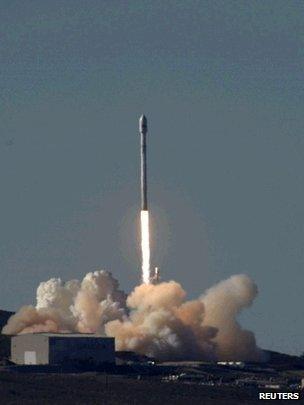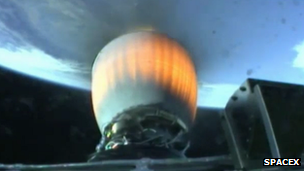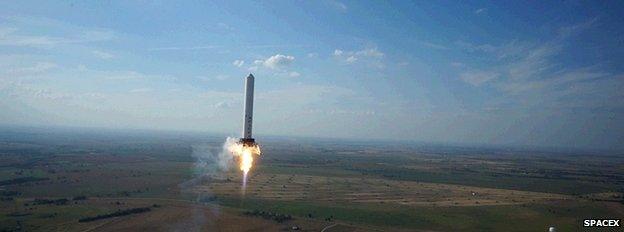Updated SpaceX Falcon rocket blasts off
- Published

It is the first time a Falcon has flown out of the Vandenberg Air Force Base
The US SpaceX company has successfully launched a new version of its Falcon 9 rocket from California.
The vehicle, carrying the Canadian Cassiope research satellite, lifted clear of the Vandenberg Air Force Base at 09:00 local time (16:00 GMT).
The desired orbit was achieved nine minutes later.
SpaceX says the updated rocket, known as Falcon 9v1.1, incorporates a number of modifications to boost performance and simplify operations.
This first outing should now open the way for the new model to begin carrying satellites for the private sector.
In addition to the business it already has with Nasa to resupply the space station, SpaceX has a long backlog of commercial customers waiting for a Falcon to launch their spacecraft.
These include the big telecommunications companies which own the platforms that relay the world's TV and phone traffic.
It is a launch market that has become dominated in recent years by the European Ariane 5 vehicle. SpaceX aims to take a large slice of its work, and is offering very competitive prices.
New opportunities
The 9v1.1 features more powerful Merlin engines and stretched tanks for additional propellant.
Sunday's launch was also the first time the rocket had flown with its new payload fairing.

The nozzle on the second-stage engine glows brightly as it powers to orbit
This 13m-tall, 5m-wide clamshell covering is necessary to protect satellites from the aerodynamic forces encountered during an ascent.
Another first was SpaceX's use of Vandenberg. Until now, all Falcon launches have gone out of Cape Canaveral Air Force Station in Florida.
The West Coast facility allows the Falcon to undertake a greater range of missions. In particular, it enables the rocket to fly south out over the ocean, away from land, to reach the polar orbits favoured by Earth observation satellites.
SpaceX CEO and chief designer, Elon Musk, expressed satisfaction with the day's events: "It was a great day and we accomplished all of our primary mission objectives.
"We demonstrated a lot of new technologies successfully, including the Merlin 1D engine, the new stage-separation system, the much taller rocket which structurally performed very well, [and] the 17-ft diameter fairing, which separated successfully. Overall - really great."
Recycling rockets
SpaceX conducted two post-mission experiments.
One was to re-ignite the second-stage after shutdown, a procedure that can be used for de-orbiting the stage but which is also used for getting geostationary satellites into their correct orbit. This re-light experiment encountered an anomaly and was not completed, said Mr Musk, "but we believe we understand what that issue is, and should have it addressed in time for the next flight of Falcon 9".
There is sure to be a lot of interest, also, in the outcome of the experiment that SpaceX ran with the Falcon's first-stage.
Normally, this initial segment of a rocket falls back to Earth after burning out and is destroyed. But the company is endeavouring to develop a system that would allow it to recover and recycle these stages, further reducing the cost of launching a Falcon vehicle.
Ultimately, the idea is for Falcon first stages to have legs to permit them to make soft landings.
During Sunday's mission, three of the nine first-stage engines were commanded to re-ignite, to see if they could bring the rocket segment down through the atmosphere intact. The centre engine of the cluster of nine was then ignited to try to slow the stage still further and control its approach to the water.
Mr Musk reported that the test went well, although the stage lost stability in the moments prior to impacting the water - a behaviour he said his engineering team understood and could correct.
"So it hit the water relatively hard," he told reporters.
"We've recovered portions of the stage. But the most important thing is we now believe we have all the pieces of the puzzle."
And Mr Musk said SpaceX would attempt to land a stage on legs, on land, early next year.
The MDA Corporation, which built the Cassiope satellite, reported that the small research platform was performing as expected after being ejected by the Falcon's second-stage. Cassiope, a project of the Canadian Space Agency, will study the Sun's interaction with Earth's upper atmosphere.
SES World Skies will be the first private sector customer to use the Falcon 9v1.1.
It has a telecommunication satellite called SES-8 that needs to be put 36,000km above the Asia Pacific region.

SpaceX has a programme called Grasshopper that is developing recoverable stage technology
- Published13 August 2013
- Published20 June 2013
- Published29 September 2013
- Published12 August 2013
- Published9 May 2013